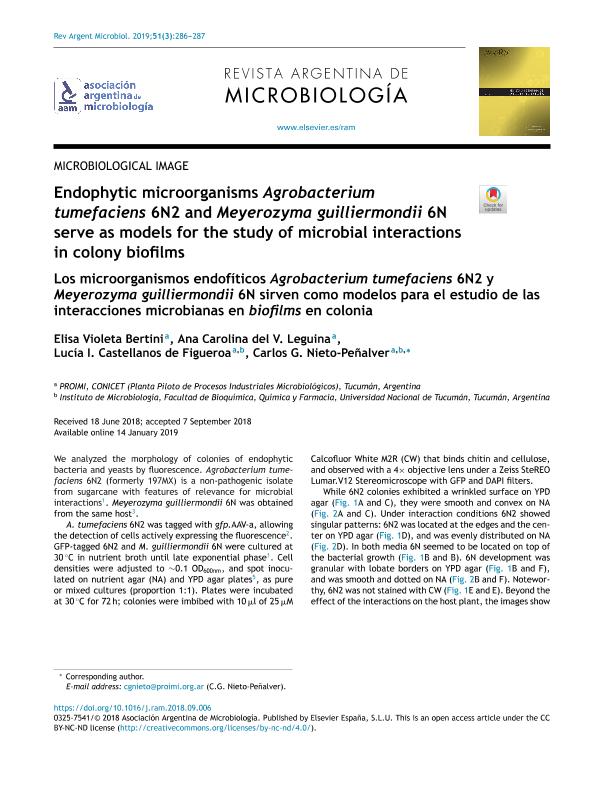Artículo
Endophytic microorganisms Agrobacterium tumefaciens 6N2 and Meyerozyma guilliermondii 6N serve as models for the study of microbial interactions in colony biofilms
Bertini, Elisa Violeta ; Leguina, Ana Carolina del Valle
; Leguina, Ana Carolina del Valle ; Castellanos, Lucia Ines
; Castellanos, Lucia Ines ; Nieto Peñalver, Carlos Gabriel
; Nieto Peñalver, Carlos Gabriel
 ; Leguina, Ana Carolina del Valle
; Leguina, Ana Carolina del Valle ; Castellanos, Lucia Ines
; Castellanos, Lucia Ines ; Nieto Peñalver, Carlos Gabriel
; Nieto Peñalver, Carlos Gabriel
Fecha de publicación:
01/2019
Editorial:
Asociación Argentina de Microbiología
Revista:
Revista Argentina de Microbiología
ISSN:
0325-7541
e-ISSN:
1851-7617
Idioma:
Español
Tipo de recurso:
Artículo publicado
Clasificación temática:
Resumen
We analyzed the morphology of colonies of endophytic bacteria and yeasts by fluorescence. Agrobacterium tumefaciens 6N2 (formerly 197MX) is a non-pathogenic isolate from sugarcane with features of relevance for microbial interactions. Meyerozyma guilliermondii 6N was obtained from the same host. A. tumefaciens 6N2 was tagged with gfp.AAV-a, allowing the detection of cells actively expressing the fluorescence2. GFP-tagged 6N2 and M. guilliermondii 6N were cultured at 30 °C in nutrient broth until late exponential phase1. Cell densities were adjusted to ∼0.1 OD600nm, and spot inoculated on nutrient agar (NA) and YPD agar plates5, as pure or mixed cultures (proportion 1:1). Plates were incubated at 30 °C for 72 h; colonies were imbibed with 10 μl of 25 μM Calcofluor White M2R (CW) that binds chitin and cellulose, and observed with a 4× objective lens under a Zeiss SteREO Lumar.V12 Stereomicroscope with GFP and DAPI filters. While 6N2 colonies exhibited a wrinkled surface on YPD agar (Fig. 1A and C), they were smooth and convex on NA (Fig. 2A and C). Under interaction conditions 6N2 showed singular patterns: 6N2 was located at the edges and the center on YPD agar (Fig. 1D), and was evenly distributed on NA (Fig. 2D). In both media 6N seemed to be located on top of the bacterial growth (Fig. 1B and B). 6N development was granular with lobate borders on YPD agar (Fig. 1B and F), and was smooth and dotted on NA (Fig. 2B and F). Noteworthy, 6N2 was not stained with CW (Fig. 1E and E). Beyond the effect of the interactions on the host plant, the images show the potential of the strains and the techniques for the study of interactions in a colony biofilm, even if the true location of each strain requires other techniques (e.g., confocal microscopy).
Palabras clave:
BIOFILM
,
COLONIA
,
AGROBACTERIUM TUMEFACIENS
,
MEYEROZYMA GUILLIERMONDII
Archivos asociados
Licencia
Identificadores
Colecciones
Articulos(CCT - NOA SUR)
Articulos de CTRO.CIENTIFICO TECNOL.CONICET - NOA SUR
Articulos de CTRO.CIENTIFICO TECNOL.CONICET - NOA SUR
Articulos(PROIMI)
Articulos de PLANTA PILOTO DE PROC.IND.MICROBIOLOGICOS (I)
Articulos de PLANTA PILOTO DE PROC.IND.MICROBIOLOGICOS (I)
Citación
Bertini, Elisa Violeta; Leguina, Ana Carolina del Valle; Castellanos, Lucia Ines; Nieto Peñalver, Carlos Gabriel; Endophytic microorganisms Agrobacterium tumefaciens 6N2 and Meyerozyma guilliermondii 6N serve as models for the study of microbial interactions in colony biofilms; Asociación Argentina de Microbiología; Revista Argentina de Microbiología; 51; 3; 1-2019; 286-287
Compartir
Altmétricas



